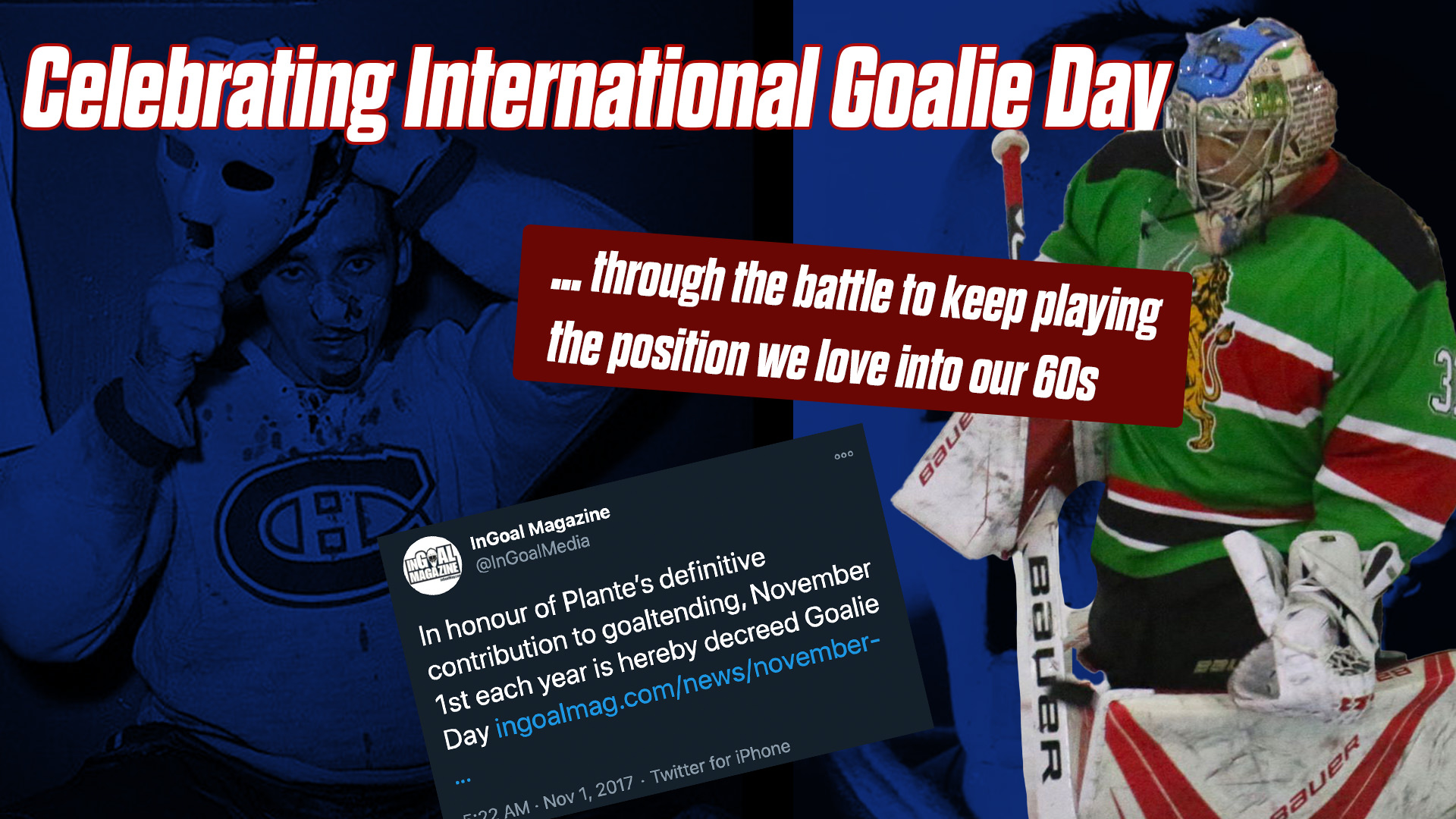
Since declaring November 1 International Goalie Day three years ago in honour of Plante’s definitive contribution to goaltending, InGoal has tried to find different ways to mark the occasion. This year, author Paul Campbell, who originated the concept of Goalie Day, confronts our mortality between the pipes through the experiences of someone who has done everything he can to push back the clock and keep kicking them out.
Tho’ much is taken, much abides; and tho’
We are not now that strength which in old days
Moved earth and heaven, that which we are, we are;
One equal temper of heroic hearts,
Made weak by time and fate, but strong in will
To strive, to seek, to find, and not to yield.
— from Ulysses, by Alfred Lord Tennyson
Considering the End
The spectre of goalie mortality chills you with a frozen shock the first time he visits. You had learned to be impervious, decades studying the art of impenetrability making you feel godlike out there in the coldest blue. You are not prepared when he forces you to consider its end. Your end, as a goaltender.
I was 32, returning to The Position after almost a decade, cobbling together the equipment. It was a Tim Horton’s parking lot (where all Canadian goalie equipment deals go down). I paid, he gave me his chest protector, and I asked why he was getting rid of it. Upgrade? Too many bruises?
“No, I’m quitting hockey” he said. He was maybe 35. “I need to be focused on my kids playing, not me.”
It didn’t quite sound like his own phrase, and though he looked resigned, it shook me. I fought every instinct to counter his statement, to make him see how strange and unnecessary his decision was. All those instincts had little to do with him – they were all about me, shuddering at the spectre I had just seen. Would I be him in a year or two? Can it be over just like that?
Become a Member to Read the Full Article
We’re working hard to bring you the best exclusive goaltending content whether you play goal, you are a coach, a parent of a goaltender, or a fan of the greatest position in sports.
All InGoal Premium members enjoy an ad-free experience.
Already a member?
10 years and three kids later, it’s safe to say I was not destined to follow his path. But after 40, the spectre settles in and starts to accompany you more and more often. Injury and extended recoveries. Declining fitness. Shifting family and life demands. An actual pandemic. His shivering whispers grow louder the older you get. Time, after all, is undefeated.
While I know I can’t ultimately win, I’m going to make a game of it for as long as possible. Looking to someone who’s gone further down the same road, a veteran of the battle you’ve only just started to fight, is an excellent way to arm yourself for the struggle to come.
I was lucky enough to have a goalie 20 years my senior reach out to me for some equipment advice in January. I ended up learning a lot more from him than he did from me, and I’m certain any older goalie who plans to play for as long as possible will benefit from his experience. Here it is.
Veteran of the Goalie Wars
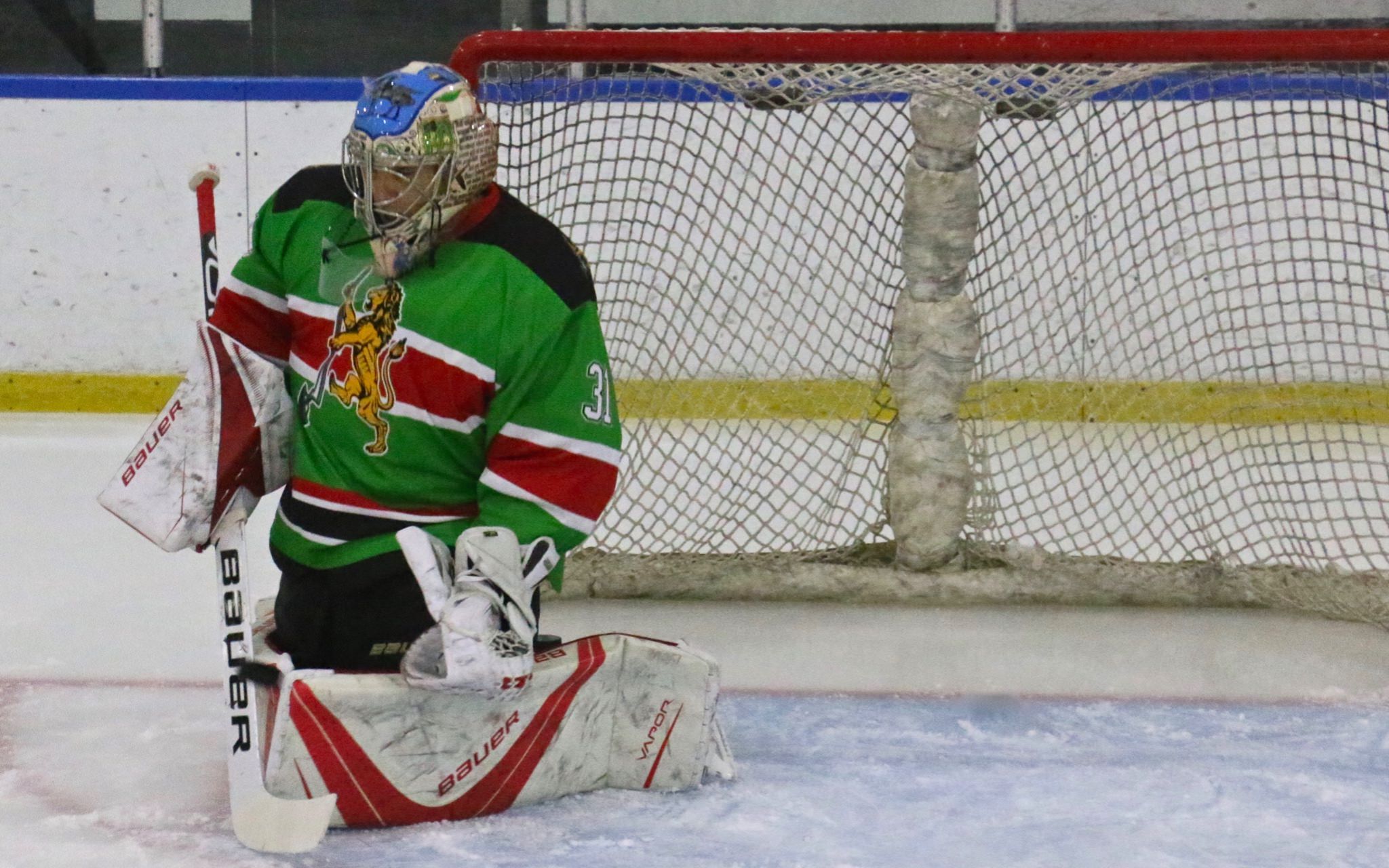
InGoal Premium Member Chris Mottola, 62, has been a card-carrying member of the Goalie Union since the 1970s. The wave of his competitive career crested in high-level junior, but his current schedule, more than 40 years later, isn’t much less full.
In the pre-Covid world, Chris was on the ice four to five times a week, including a standing pickup game with former junior and collegiate players (ranging in age from their 20s to their 40s), a session with goalie coach Danny Vitale, and an hour spent as a target at a learn-to-play-hockey drop-in.
That’s enough weekly hockey to make most beer leaguers jealous; it’s also more than enough to make most beer leaguers immobile with muscle strain, joint wear, and fatigue. Chris’s body certainly hasn’t escaped unscathed.
Like so many goaltenders, Chris started experiencing pain and decreased mobility as a result of hip problems, and in 2014, he underwent surgery to repair his right hip, where bone was grinding onto bone.
The spectre of goalie mortality had paid him a chilling visit.
“I thought it might be over” Chris remembered all too vividly over the phone. “It made me realize how much the game meant to me, and how much of my identity was defined by it.”
Improving after Hip Surgery
Determined to return, Chris followed the regimen set out by his doctor and therapist to the letter. He dropped 10 pounds before surgery (on the advice of his surgeon) to make recovery easier, and did the at-home physical therapy religiously.
“They tell you to do an hour every day” Chris recalled, “expecting you to do maybe half that. I did the whole thing, every time.”
And it paid off. Within four months, he was out at a public skate. Six months to the day of his surgery, he was back in goal, an impressive recovery for a man in his mid 50s. The experience had a profound effect, not only on his body, but on his whole approach to The Position.
“You have to wrap your head around not being the same goalie you were in junior. Now I was doing it for fun, for the love of the game, for exercise, and to get better.”
The surgery and therapy enabled him to play again, pain free for the first time in years, but it also revealed some unfortunate wrinkles, Chris notes: “For the first time as an adult, both my legs were the same length. All my mechanics, from my skating stride to crease movements, felt totally off. I realized my body had been using workarounds and shortcuts to compensate, and now none of them worked.”
His slow return to normal goaltending function was accelerated by an unexpected Valentines present from his wife in 2015: a ticket to the LA Kings Fantasy Camp.
It was there on the ice that Chris met Jamie Storr, former NHL goaltender, who offered to help him remake his post-surgical game. Within two months, Chris went from being an old-school 90s style butterfly/hybrid goalie, to having the foundations laid for a modern down game (going easy on the VH and RVH, of course). It convinced Chris that some intense coaching – beyond his annual July clinic with long-time coach and friend Yona Fioravanti – would be vital when relearning to play after a mobility-impacting injury or surgery like he had.
“A good coach will see and fix the poor mechanics and inefficiencies you’ve been compensating with forever,” he said. “On your own, it might never happen, and you’re repeating the same old movements that injured you in the first place.”
It might seem counter-intuitive that a modern down game could be easier on a body, with all the joint impact of frequent dropping and the hip strain that comes with rotating and pushing while kneeling. However, performed according to the right biomechanical principles, the modern down game moves a goalie from point A to point B far more efficiently, with less strain, and less impact, than the hybrid butterfly game many of us older goalies learned in the 90s.
The modern game is more precise and deliberate, mitigating the loss of athleticism due to age with the removal of delays and inefficiencies.
“I’m a better goalie now than I was in my 40s,” Chris said, convincingly. “And after my first surgery and working with Storr, and then with Vitale, I enjoyed playing more than I had since my late teens.”
I can see some of you empathically wincing at the implication of Chris’s phrase “first surgery.” Early in 2019, he started experiencing pain in his left hip, and quickly discovered he had the same kind of deterioration that lead to his previous surgery.
Looking around for possible therapeutic, non-surgical options, Chris discovered Pilates; its central focus on core strengthening and proper biomechanical alignment (including the neutral pelvis that features so prominently in elite NHL goalie trainer Adam Francilia’s philosophy) allowed him to play for several months before the pain returned and demanded a more invasive intervention.
Chris followed the playbook he developed for his first surgery, and was on pace to hit the ice even more rapidly than before. Then, a pandemic shut everything down, and left Chris, and almost every other goalie of any age in North America, with nowhere to play and very little to do.
As usual, Chris made the best of his situation: “I just did what any goaltender does when they can’t go out and actually play. I started looking at gear.”
Modding Pads to Protect Hips
This is when Chris reached out to me, asking about pad options for a (then) 61 year old goalie with two replacement hips and a desire to feel more connected to his pads, but also less strained by them. I proposed jury-rigged knee pad layers made of a basketball knee sleeve with a soft, thick volleyball kneepad on top, all to go under the goalie knee pad (which itself goes under the large, long leg pads).
My colleagues at InGoal sent some useful strapping options, and as usual, Chris came up with something that surpassed everything we told him.
The first mod was a no brainer from a both a feel and tension standpoint: he replaced his shoelace toe ties with elastic versions:
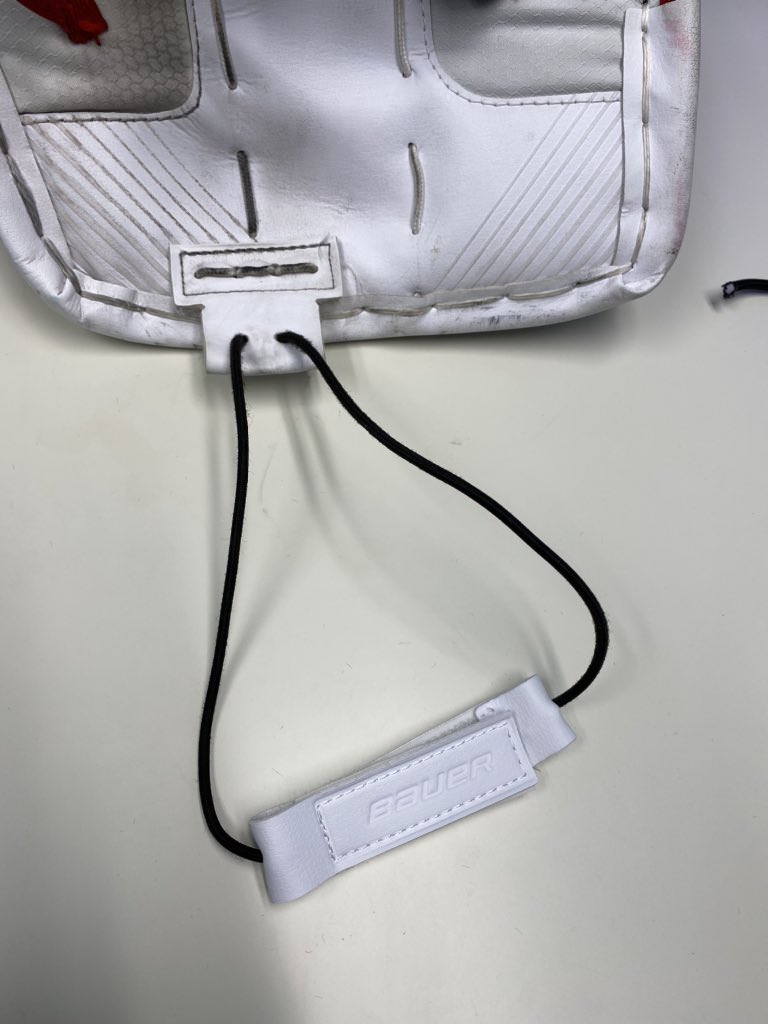
The elastic keeps the pad feeling more connected to the skate, and allows it to snap back to the front more quickly after recovering to your feet. The elastic also stretches enough to accommodate full rotation, easing strain on the leg that can be caused by a fixed lace preventing the pad from rotating beyond a given point.
Next, Chris decided to add a professor strap to each pad:

Finally, Chris’s real masterpiece (besides his mask, which is an absolutely inspired design worthy of its own article) comes courtesy of Protective Athletic Wear (PAW). A set of custom Viscoelastic gel knee pads helped to both reduce impact on his knees and raise them on his blocks, while a new, far thicker set of custom knee blocks with a gel top flap intensified both effects even further.
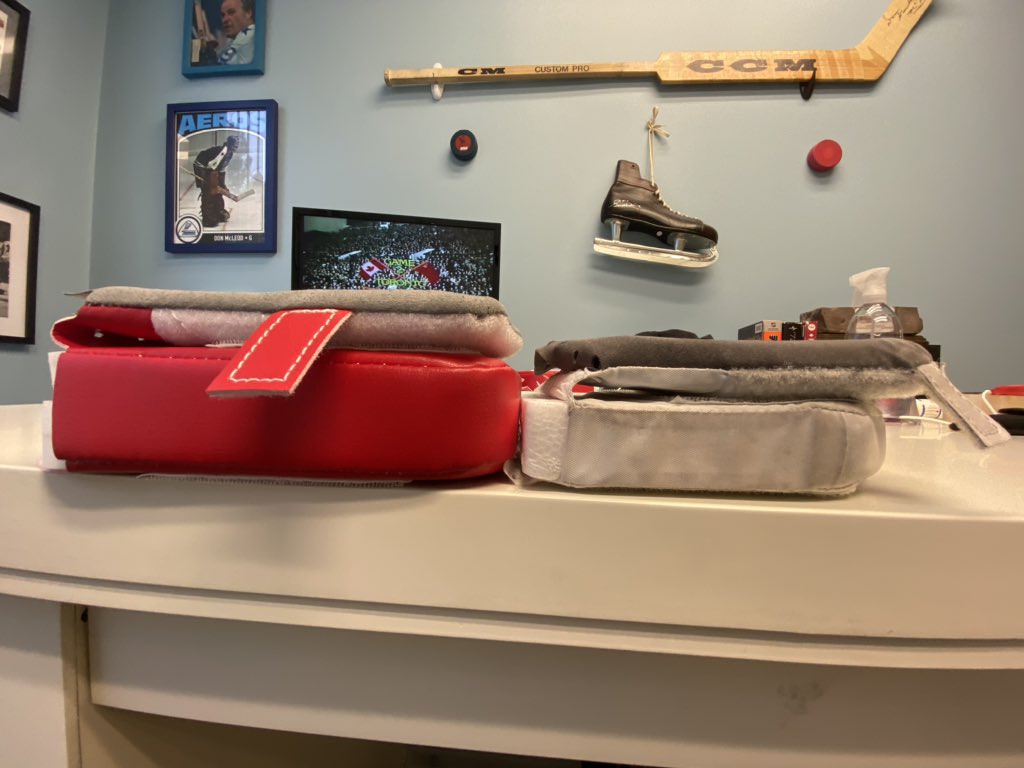
The higher the knee is above the ice when down in butterfly, the less strain on the hip. An added benefit is that it takes less time to close the five hole, allows for a wider butterfly flare, and keeps the skate at a better angle for regaining an edge – these are the performance improving factors that make it illegal for NHL goalies to have stacks this thick.
Installed, it also becomes clear that the sheer width and blocky thickness of the new stacks creates a stiffer, more reliable landing surface.
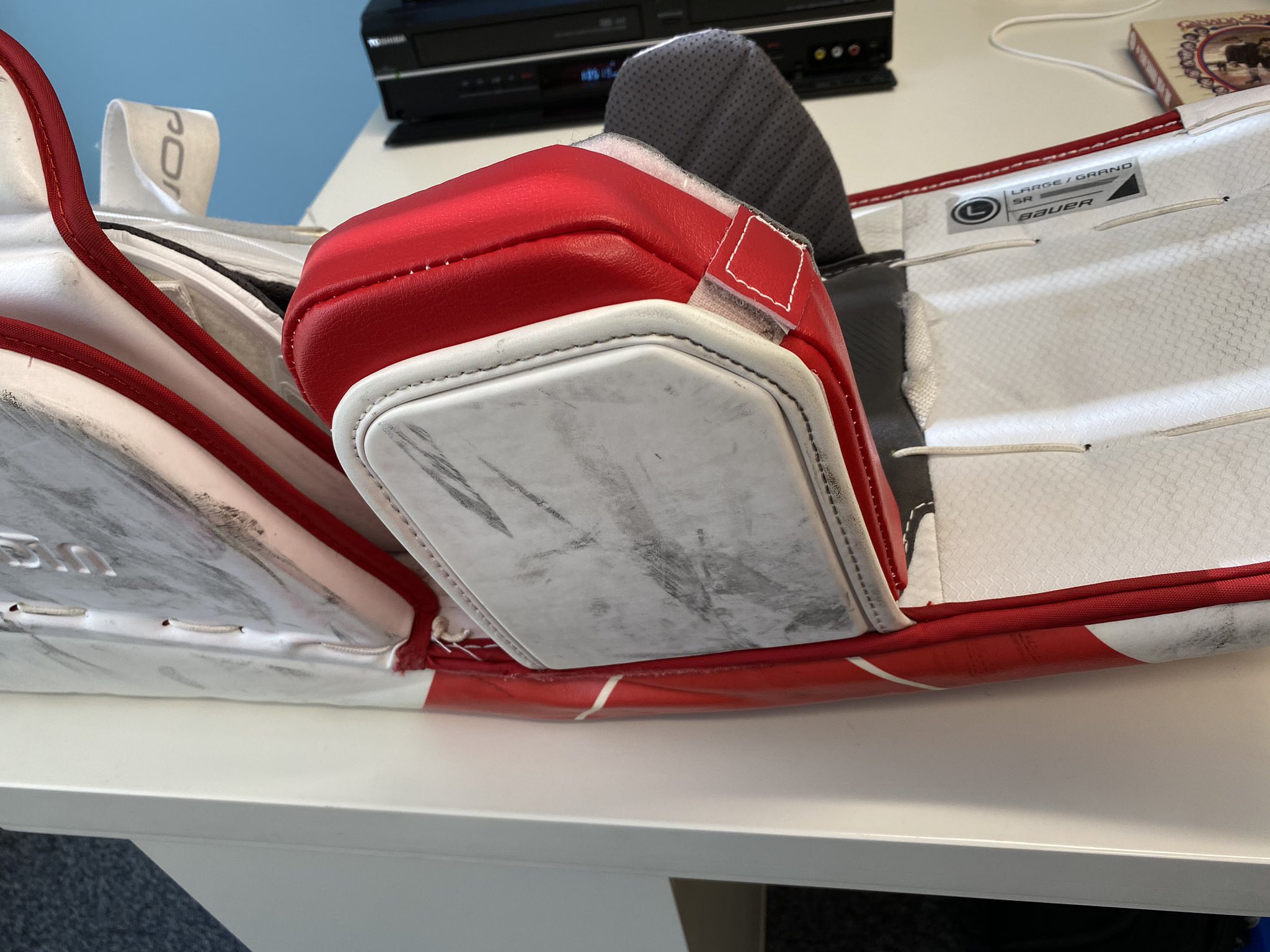
After a couple of months on the ice, Chris reports that the equipment is having the desired effect: less strain and impact stress, and greater mobility. It’s a combination that any goalie, but especially those of us over 40, could really benefit from.
Just the Beginning
Most goaltending resources are aimed at two groups – professionals and children.
Unfortunately, the motivations, life circumstances, and physical characteristics of older goalies mean that what works for the other two groups won’t always work for them. By spotlighting an older goaltender and the steps he’s taken to maximize the quality and longevity of his game, we hope to spark some larger conversations about the needs of The Position’s longest serving members.
Many thanks to Chris Mottola (@mottocto on Twitter) for sharing his story, and providing some excellent ideas for an underserviced slice of the goalie community.
Do you have an equipment mod, technical suggestion, or any other tips or tricks you’ve found effective as an older goalie? Please share them in the comments below, on our social media channels, and anywhere else goalies talk shop.
Comments
Let's talk goaltending!
We welcome your contribution to the comments on this and all articles at InGoal. We ask that you keep it positive and appropriate for all - this is a community of goaltenders and we're here for each other! See our comment policy for more information.




Great story! I love this line from the story, ( It was a Tim Horton’s parking lot (where all Canadian goalie equipment deals go down)
57 years old relearning the position. Not the same one I new as a child,
It’s a whole new game now! Fortunately, once you get it, your teammates will thank you.
I am 68 years old and playing pickup 3 times a week year round with players between 16 and 55, average ages 20 to 40. Most of our skates have some current juniors, college and ex college players, and our Friday skate even has a few players who have played professionally here and in Europe. I’m playing strictly for fun now, and enjoying it very much.
I’ve been pretty lucky with injuries aside from both hips replaced (arthritis) and metal in my shoulder from a torn rotator cuff. I can totally relate to several adjustments mentioned in the article including built up knee blocks, gel knee pads, and elastic toe ties. I also bought the lightest pro level equipment I could find, 100% Warrior gear.
I know I’m not as mobil, and certainly not as pretty as the younger guys, but I (mostly) make up for it by positioning and years of experience reading plays. Originally a stand up goalie from the 1960’s, I learned to play the hybrid game when I made my comeback 12 years ago after the hip surgeries. It’s funny, but the younger guys especially are surprised sometimes when they see a goalie coming out beyond the blue paint and staying high right as they shoot (thanks Bernie Parent, haha)
I consider myself very lucky that I’m still playing and having fun, which for me was what it was all about from the start.
Love to hear stories like yours; wisdom and experience trump pure athleticism more often than you’d expect. Some of the young shooters are baffled by goalies who don’t retreat (and who flash the odd long poke check).
So great to see so many goalies in their sixties. It’s the best position in the best sport.
What was the Mike Richter line? ‘You don’t chose to become a goalie, the position chooses you.’
Inspirational. I am 61 and recently shelved by ankle, hip, and long standing knee issues. So I see there is hope.
This is great to hear, Paul – there’s so much more, in terms of preparation, training, and equipment, available now than there ever was when I was growing up in The Position. I’m rooting for you to make it back out there, as mobile and free of discomfort as possible.
Hey Chris & Paul, I can relate! I’ll be 62 in a couple of weeks and I still goaltend three or four times a week in open leagues and skates (two regular teams), routinely playing with guys in their 20’s and even teenagers. I am totally self-taught – never played organized hockey – and really didn’t start until my mid-20s. (Dabbled at stick times as a kid, but never owned my own gear until I was an adult.) My one hip is arthritic, but not bad enough to stop me (yet). I quit using toe ties of any kind about five years ago and found that really helped ease discomfort in my hips and ankles. One of my sets of pads have an extra knee block in them and I like that a lot too. I’d love to get some honest-to-goodness goaltending instruction (still read here and work hard on my conditioning and technique), but who coaches a 60+ year old guy? I play a hybrid style and I find that it is often to my advantage that all these young guys typically shoot high cuz that’s the percentage play against today’s “down” goalie… then they’re pissed to find that I’m standing up and their shot bounces harmlessly off of my shoulder. lol
Keep those kids guessing Ray! It’s funny which sports are “acceptable” for older people to be coached in. A 65 year old with a golf coach is totally fine, and people talk about working on their golf game their whole lives. No reason it shouldn’t be the same for goaltending. The sheer amount of technical content specific to The Position means that instruction and practice can make a huge difference in how you feel, and how you play.
Thanks Paul. Any ideas about old-guy goalie coaches in the Pittsburgh area?
Hey Ray.
My experience with coaches and older goalies has been great. First, they enjoy us because of our passion for the game. Second, we learn pretty quickly. (And forget even quicker.) Third, when they pair us with younger goalies the message is, “If this dude who could be your grandfather is humping it through this drill, you need to give me more.” Fourth, we are good for the money. ?
I’ll ask my PA peeps if they know any goalie coaches in the PGH area.
Thanks Chris. I could use some instruction, for sure, since – you know – I’ve never had ANY. lol For instance, I cannot teach myself to slide at all. I try to plant my skate and push, but… nuthin’. Any guidance would be much appreciated.
Ray
53 yo goalie in South Hills. I’ve been working with Shane Clifford’s guys and Mike Yaremko. Highly recommend. I can give you more details if required.
Great read as always, Paul. You and Chris happen to be two of my favourite tweeps.
Chris inspires me. I’m just a 1963 model year baby.
The professor straps are something I will be looking into. I have something similar from another company but the design of those look like it would help me.
Thanks Boosh! I love the little goalie community we have going on Twitter, and it’s great to see it coming through here at InGoal, too. The big stacks are the thing that really draw my eye. Chris has 20 years on me, but if I start mitigating hip stress now, I might not have to get them replaced.
Fantastic article. Thank you for this. As a 1959er felt a bit alone out there playing 3 to 4 times a week with a lot of younger guys. And its great to know there is still “runway” out! I tell people that look at me a bit funny when I tell them that I am still playing that it is because the equipment is much lighter but although its a factor, I really think its because the chest protectors have gotten so much better. I don’t walk around bruised like I did even in my 40’s. (People can talk about all the changes to goal equipment but I think the biggest change in hockey is player carbon fibre sticks). Have about 5 chest protectors hanging in the garage looking for the perfect balance of protection and weight. Settled on Warrior for now but switch in the Vaughan for its mobility and air circulation now and then but find the arms a little thin. Pre-COVID the focus was on finding the best sliding pads. Need all the help I can get on getting over on this new East-West game. Have a new set of Brian’s GNetiK’s I can’t wait to try when we can get back on the ice. In the meantime, the other big takeaway from the article is looking for a place for lessons. Efficiency=playing longer and I just love this game!
Daniel, I dream of being where you and Chris are when I’m your age – the steps Chris outlined for me wrt exercise and equipment mods should help, too. Have you heard of Passau? They get little press, but their chesty is stellar. Mobile immediately, and the protection is excellent. Where are you located? We might be able to connect you with a coach or two working in your area.
Paul. Thank you very much. I will take a look at Passau. Heard of them but I have never seen their equipment at retail but will look into them. Live in Niagara on the Lake but play in Toronto. Any help you could provide on coaching suggestions would be greatly appreciated.
Daniel, you are so right about the chest and arms. Those of us that played in the 70s/80s, understood stepping on the ice meant you were always going to get dinged.
I went through a bunch of models until I found one that worked for me. (Brown.) Overlooked in the c/a is a proper fit.
Thanks Chris. Will look into them as well.
Great to hear these stories. I’ve been playing goal since I was 13 and I’m 62 now. Pre Covid played 2-3 times a week in the winter and just picked up a few games in the summer. Love this game more now than ever before. This Covid thing is got me itching to get out there. The biggest joy was being able to have my Son join my team when he turned 19. He is now 34 and now I’m his EBUG for his team. This is fun playing on his team with his buddies and them handing me a beer and saying Pop’s you looked pretty good out there.I don’t think I can hang on long enough to play on the same team as my 6 year old grandson when he turns 19.
Guys and Gals just keep having fun out there as that’s what it’s all about. Keep doing those pre game stretches and stay healthy and safe on and off the ice.
great stuff – thanks for sharing! I’ve been lucky enough to play goal with my son in net at the other end a few times – pretty special stuff for sure!
Chris, did you have total hip replacements done? I was in that boat 5 years ago when I ‘first quit’. I held off on the surgery and luckily ended up in the hands of a surgeon who does total hip resurfacing. The bone structure is maintained and new titanium surfaces are implanted. Proud to say that a year and a half after my last surgery I feel better in the net at 45 than I did at 35. Super interested to learn how you constructed the knee stacks. I want to do the same to alleviate as much strain as possible to extend the life of my titanium. I know one thing I’ve done is switch to all Velcro straps less the boot, and the Velcro strap up top goes from the knee stack to upper calf. I think it was determined that strapping option also alleviates strain (by Ryan Frayne and CCM I think.).
I am 55 and get on the ice 3-4 times week including a “Murder Hockey” hour at a 3 on3 small sheet training facility. Everyone is always younger than I am and I keep saying that as long as I do not embarrass myself, I’ll keep suiting up. I also threaten to play up regularly, so I can show them how it is really done :). That was a great article and got a few tips already to make equipment work for me. I just changed pad set up this year and brands. The bungee toe loop was a big game changer for me, but I am interested in the the gel knee cushions. Can you provide more info on where to get them?
Just joined InGoal, and loved this article. I’m 60, and like most guys here skate with guys and gals from their teens up to their 70s. I figured I only had a couple years left, but the comments here have really encouraged me. Thanks, gents!
Awesome Paul ! Welcome aboard!
Sorry I’m so late replying.
I’ve had both hips replaced. I was back to playing 6 months and 4 months respectively.
I ordered the knee stacks from PAW (Protective Athletic Wear) the owner is also a goalie. They were an easy attachment. Along with reducing hip strain, they gave me a wider butterfly.
Stephane Pelletier: I ordered the knee protecter/gel from PAW (Protective Athletic Wear) the owner is also a goalie. There is also gel on the moded knee stacks as well. (They are illegal in some leagues, but not most beer leagues.
I love the comments and equipment ideas. I’m 76 and playing one a week with 30- 40-year-olds. In October I played for team USA 80+ against team Canada 80+for the Canada 150 Cup in Burlington Ontario. Team USA 80+ players came from all over the US. All the players had to be 80 years old except the goalies who could be 75 or older. It was great to be the youngest on the US team. Team USA won the cup. I started goaltending at 34 and after 5 right knee and one left knee surgeries and 2 left and right shoulder surgeries my surgeon can’t figure how I can still play. Passion for the game is why. I’m looking at a shoulder replacement and would like to know if any goalie out there is still playing with a shoulder replacement.